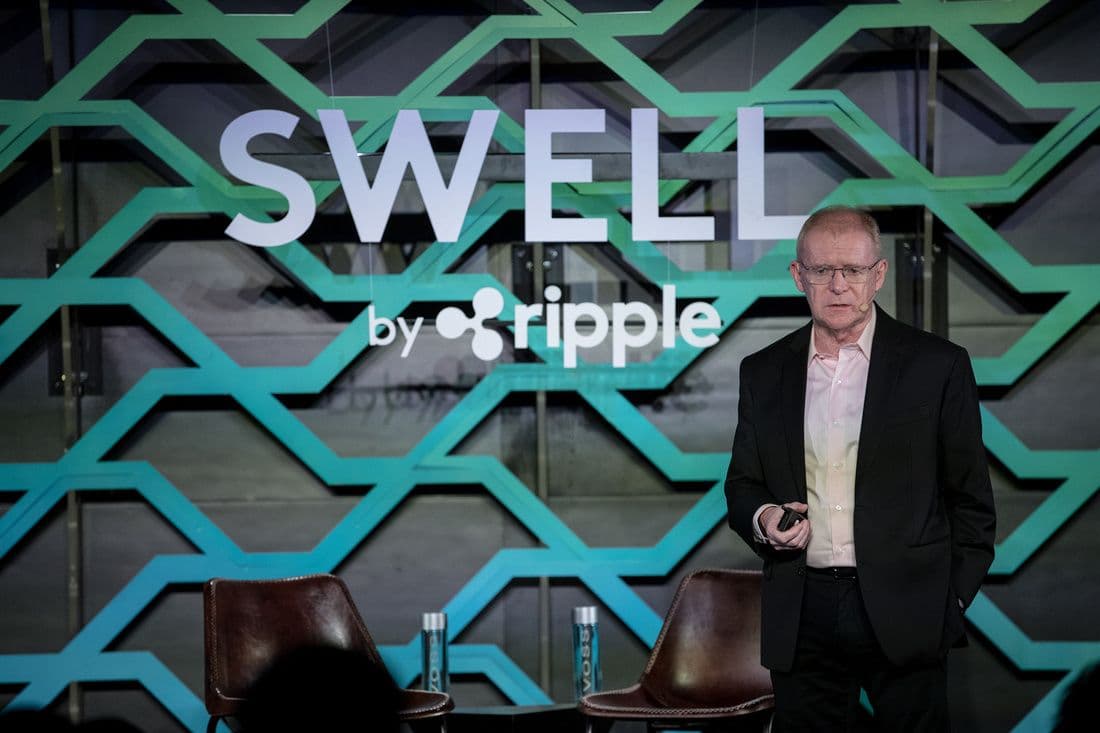How does a 111-year old bank go about reinventing itself? According to Siam Commercial Bank SEVP, Chief Technology Officer & Head of Operations Colin Dinn, it’s about finding the right partner to help aggressively solve problems with an eye towards the future.
Dinn took the stage at Swell to unpack how Siam Commercial Bank (SCB) is working with Ripple, and the unexpected impact it has had on their business. He pointed out that the relationship is rooted in a transformation process that began two years ago to turn a formal, traditional bank into one that uses technology as a lever to explore new business and delivery models.
In his words, SCB “was a product-led bank” that focused on pushing product to customers. They now prioritize a heightened commitment to customer-centricity, meaning they give customers what they want versus what the bank needs to sell. This is in part driven by their realization that banks as they exist today will not be relevant five years from now. To survive and remain competitive, SCB needed to reinvent itself.
One of the most pressing customer pain points in the Association of South Eastern Asian Nations (ASEAN) region is remittances. Lacking a reliable and populated network of correspondent banks, the region faces abnormally high inefficiencies and costs for cross-border payments.
With its customers distributed around the region, Thailand-based SCB sought a way to make remittances faster, easier and more affordable. True to their new spirit of transformation and modernization, they looked for a partner with vision and a culture of experimentation that would aggressively collaborate with them. According to Dinn, SCB desired a partner that had “aggressive ambition” and could “push the envelope of what’s possible and then define one step beyond.”
The team found that partner in Ripple. SCB kicked off its collaboration to reimagine international payments with Ripple using a four-step approach:
1. Understand the technology – Before implementing the new technology, SCB needed to take a deep dive with Ripple to understand how it could best address the bank’s remittance challenge.
2. Design the business model – This involved scoping out how SCB would alter its approach and required design elements, briefing senior management and securing final approvals. Dinn shared that this was a longer, more rigorous step than the previous and was completed in roughly six months.
3. Prove the capability – In July, SCB launched its new retail product in partnership with SBI Remit for the Japan-Thailand remittance corridor. Knowing this would require regulatory approval, SCB launched the product live in a sandbox with their regulator, the Central Bank of Thailand. With early success, SCB is now adding more retail partners and designing the criteria with the Central Bank that will enable it to move the product out of the sandbox.
4. Build a sustainable business – After demonstrating business value and future promise in the sandbox, the SCB team is building a framework around it to create a sustainable business unit. The focus for the team is how to build and scale this approach effectively.
This last step is where the value of Ripple was truly unlocked. The partnership with Ripple has shown SCB that there is a better way to operate in the region. Dinn said the bank is committed to growing the initial scope of work beyond just facilitating remittance payments back to Thailand into crafting a regional clearing mechanism for payments. SCB believes the opportunity exists to build an entire ecosystem around these technologies for the broader ASEAN region.
In one early expression of this growth, SCB announced in September that they will be the first to pioneer a key feature called “multi-hop.” In a region without a mature and pervasive correspondent banking network, this capability allows SCB to act as a middle stop to facilitate international payments between two banks that do not share a direct correspondent relationship. It’s a compelling way to reduce frictions and costs in cross-border payments that also helps SCB grow their business and reach.
According to Dinn: “(SCB) did not have this in mind when we started…all we wanted to do was make international payments a lot easier.” He went on to say that with their shared ability to experiment, Ripple and SCB have identified a different way to do things, leading to this regional clearing partner strategy.
Dinn wrapped up by explaining that the partnership with Ripple “goes beyond supplier-buyer” relationships and is instead a partnership to create and build something different than one might initially expect. For others seeking a similar path, Dinn suggests beginning with the key questions: “What problem are we trying to solve, and how will we get there?”
To learn more about RippleNet, contact us directly, and watch additional Ripple customer stories in the Swell 2018 video series.







